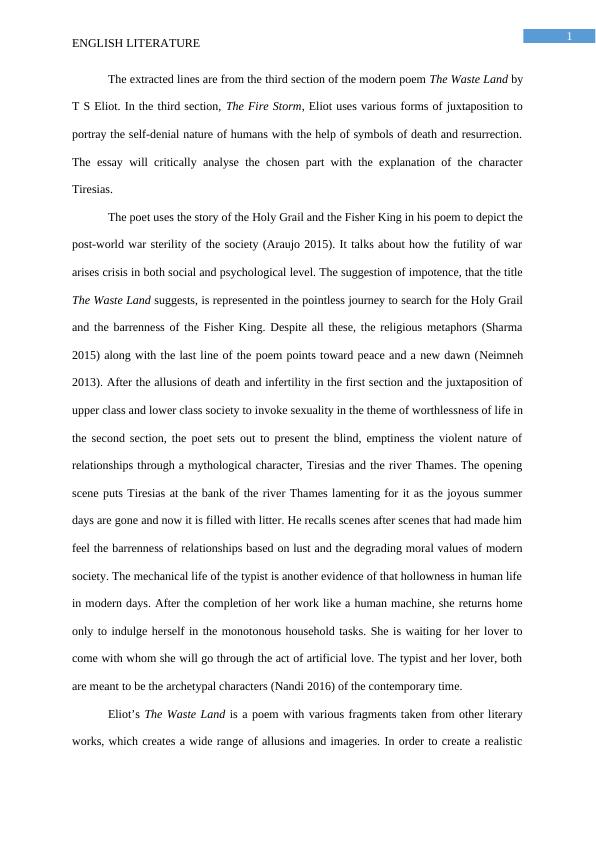Analysis of T.S. Eliot's The Waste Land: Juxtaposition and Characterization
Added on 2023-06-11
4 Pages1033 Words499 Views
Running head: ENGLISH LITERATURE
English Literature
The Name of the Student:
The Name of the University:
Author Note:
English Literature
The Name of the Student:
The Name of the University:
Author Note:

1
ENGLISH LITERATURE
The extracted lines are from the third section of the modern poem The Waste Land by
T S Eliot. In the third section, The Fire Storm, Eliot uses various forms of juxtaposition to
portray the self-denial nature of humans with the help of symbols of death and resurrection.
The essay will critically analyse the chosen part with the explanation of the character
Tiresias.
The poet uses the story of the Holy Grail and the Fisher King in his poem to depict the
post-world war sterility of the society (Araujo 2015). It talks about how the futility of war
arises crisis in both social and psychological level. The suggestion of impotence, that the title
The Waste Land suggests, is represented in the pointless journey to search for the Holy Grail
and the barrenness of the Fisher King. Despite all these, the religious metaphors (Sharma
2015) along with the last line of the poem points toward peace and a new dawn (Neimneh
2013). After the allusions of death and infertility in the first section and the juxtaposition of
upper class and lower class society to invoke sexuality in the theme of worthlessness of life in
the second section, the poet sets out to present the blind, emptiness the violent nature of
relationships through a mythological character, Tiresias and the river Thames. The opening
scene puts Tiresias at the bank of the river Thames lamenting for it as the joyous summer
days are gone and now it is filled with litter. He recalls scenes after scenes that had made him
feel the barrenness of relationships based on lust and the degrading moral values of modern
society. The mechanical life of the typist is another evidence of that hollowness in human life
in modern days. After the completion of her work like a human machine, she returns home
only to indulge herself in the monotonous household tasks. She is waiting for her lover to
come with whom she will go through the act of artificial love. The typist and her lover, both
are meant to be the archetypal characters (Nandi 2016) of the contemporary time.
Eliot’s The Waste Land is a poem with various fragments taken from other literary
works, which creates a wide range of allusions and imageries. In order to create a realistic
ENGLISH LITERATURE
The extracted lines are from the third section of the modern poem The Waste Land by
T S Eliot. In the third section, The Fire Storm, Eliot uses various forms of juxtaposition to
portray the self-denial nature of humans with the help of symbols of death and resurrection.
The essay will critically analyse the chosen part with the explanation of the character
Tiresias.
The poet uses the story of the Holy Grail and the Fisher King in his poem to depict the
post-world war sterility of the society (Araujo 2015). It talks about how the futility of war
arises crisis in both social and psychological level. The suggestion of impotence, that the title
The Waste Land suggests, is represented in the pointless journey to search for the Holy Grail
and the barrenness of the Fisher King. Despite all these, the religious metaphors (Sharma
2015) along with the last line of the poem points toward peace and a new dawn (Neimneh
2013). After the allusions of death and infertility in the first section and the juxtaposition of
upper class and lower class society to invoke sexuality in the theme of worthlessness of life in
the second section, the poet sets out to present the blind, emptiness the violent nature of
relationships through a mythological character, Tiresias and the river Thames. The opening
scene puts Tiresias at the bank of the river Thames lamenting for it as the joyous summer
days are gone and now it is filled with litter. He recalls scenes after scenes that had made him
feel the barrenness of relationships based on lust and the degrading moral values of modern
society. The mechanical life of the typist is another evidence of that hollowness in human life
in modern days. After the completion of her work like a human machine, she returns home
only to indulge herself in the monotonous household tasks. She is waiting for her lover to
come with whom she will go through the act of artificial love. The typist and her lover, both
are meant to be the archetypal characters (Nandi 2016) of the contemporary time.
Eliot’s The Waste Land is a poem with various fragments taken from other literary
works, which creates a wide range of allusions and imageries. In order to create a realistic

End of preview
Want to access all the pages? Upload your documents or become a member.
